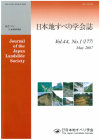
- Issue 6 Pages 249-
- Issue 5 Pages 197-
- Issue 4 Pages 125-
- Issue 3 Pages 79-
- Issue 2 Pages 37-
- Issue 1 Pages 3-
- |<
- <
- 1
- >
- >|
-
Yoshikazu KIMURA, Sho KOMATSU, Shinro ABE, Shingo SUZUKI, Tadashi NISH ...2017 Volume 54 Issue 6 Pages 249-258
Published: 2017
Released on J-STAGE: April 13, 2018
JOURNAL FREE ACCESSMagnetic minerals, such as iron, are contained in natural materials like rocks or sediments. These minerals possess the property of acquiring magnetization that corresponds to the prevalent geomagnetism at the time of their formation.
After acquisition, the magnetization is preserved for a few million years as remanent magnetization, which can provide us with an index related to the direction and inclination of the magnetic north. We can thus discuss whether the materials at a certain place were displaced due to a landslide or a bedrock collapse in the past.
In this study, we measured remanent magnetization and mineral composition and age of the Quaternary volcanic products around the Gassan Shizu landslide area for the purpose of elucidating the landslide process of movement and spectrum.
The analysis results have become indexes of risk assessment and countermeasure-planning of the Gassan-Shizu landslide.
View full abstractDownload PDF (4561K)
-
Ryohei SUGII, Ryoko NISHII, Yasuo ISHII2017 Volume 54 Issue 6 Pages 259-268
Published: 2017
Released on J-STAGE: April 13, 2018
JOURNAL FREE ACCESSThis paper presents a method to evaluate the urgency of failure based on temporal variation in strain and strain rate observed in the 34 landslides. The results show that the reliability of conventional prediction method of failure time tended to be improved by use of data observed after the rapid increase of strain and strain rate (acceleration point). In collected records, the strain and strain rate at the acceleration point and just before failure exceeded certain values. These results suggest that the urgency of failure can be classified into three stages by setting threshold values for strain and strain rate of landslide.
View full abstractDownload PDF (3447K)
-
Tomohiro YAMADA, Takeo MITSUNAGA, Yoshitaka SHIGIHARA, Toshikazu KUBOT ...2017 Volume 54 Issue 6 Pages 269-276
Published: 2017
Released on J-STAGE: April 13, 2018
JOURNAL FREE ACCESSDownload PDF (3210K) -
Yasuhisa HINO, Kenji KASHIWAGI, Hidehisa NAGATA2017 Volume 54 Issue 6 Pages 277-282
Published: 2017
Released on J-STAGE: April 13, 2018
JOURNAL FREE ACCESSDownload PDF (1927K) -
Hideyuki KAWAMATA, Satoru YAMABE, Takumi KAWASAKI2017 Volume 54 Issue 6 Pages 283-288
Published: 2017
Released on J-STAGE: April 13, 2018
JOURNAL FREE ACCESSDownload PDF (3212K)
-
Epilogue of the Series “Aerial watching of landslides in Japan”Hiroshi YAGI, Takashi INOKUCHI2017 Volume 54 Issue 6 Pages 289-293
Published: 2017
Released on J-STAGE: April 13, 2018
JOURNAL FREE ACCESSDownload PDF (2268K) -
Tamotsu NOZAKI2017 Volume 54 Issue 6 Pages 294-297
Published: 2017
Released on J-STAGE: April 13, 2018
JOURNAL FREE ACCESSDownload PDF (1943K)
- |<
- <
- 1
- >
- >|